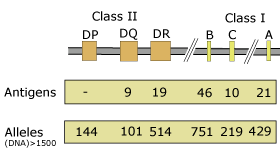HLA typing
Incompatible HLA-molecules represent the major transplantation barriers in HSC. HLA typing refers to the analysis of the HLA class I and class II genes expressed by an individual. SerologySerology has been the first technique to detect the polymorphism of HLA antigens. Typing reagents consisted of sera of multiparous women, or of immunized blood donors that had received multiple transfusions. Because serology is based on the recognition of HLA molecules by the antibodies in the alloantisera only antigenic differences, that is differences in ternary structures of HLA-molecules recognized by antibodies, between HLA antigens are discriminated. However, many differences between HLA alleles that are not recognized by the allosera, can be recognized by allogeneic T cells that will start GVHD or graft rejection. Read more...
Molecular (DNA based) typingThe lack of monospecific alloantisera, the requirement for viable lymphocytes, and the low resolution of the method, stimulated the development of genomic DNA typing techniques (initially for HLA class II, later also for HLA class I typing). Various HLA typing methods based on DNA sequence have been developed. These high resolution DNA typing methods revealed the true extent of HLA polymorphism and most HLA antigens defined by serology appeared to consist of numerous alleles with small sequence variations resulting in one or a few amino acid differences. The number of alleles at each locus in the IGMT/HLA sequence database is constantly updated. Read more... Cellular assaysIn addition to the serology and molecular typing techniques, several cellular tests such as the frequency analysis of cytotoxic T lymphocyte precursors (CTLpf) or the mixed lymphocyte culture (MLC) can be used for functional matching. Read more... Typing strategiesObviously, the typing strategy depends on the type of transplantation (HSCT or organ) and the HSCT donor (related versus unrelated). Read more... |
|
|
Transplantation Immunology | |||||||||||||||||||
|
||||||||||||||||||||



 Print
Print